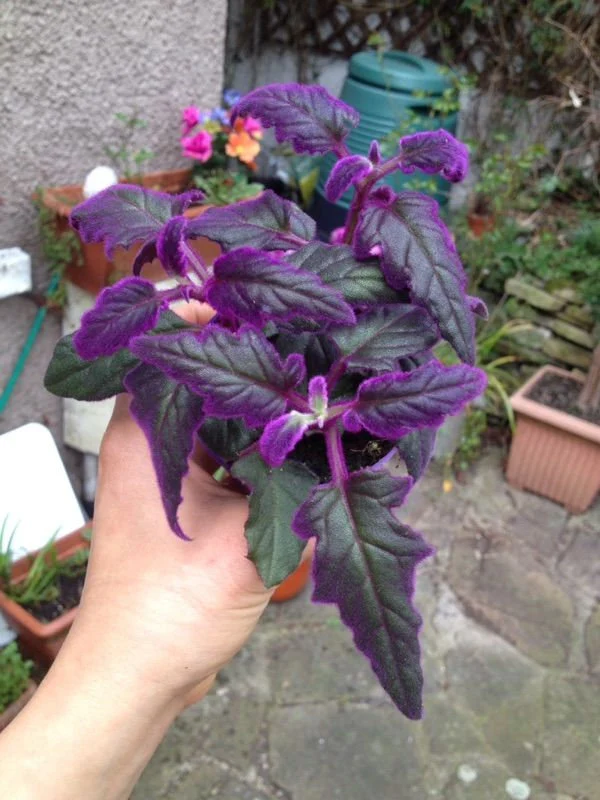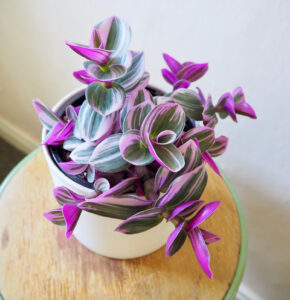Purple Gynura, also known as Gynura aurantiaca or Purple Passion Plant, is a vibrant, tropical plant admired for its striking purple-hued foliage and fuzzy, velvety texture. Here’s a care guide to keep your Purple Gynura thriving:
1. Light Requirements:
- Bright Indirect Light: Purple Gynura thrives in bright, indirect light but can tolerate some direct sunlight. Too much direct sun can scorch the leaves and diminish their vibrant purple color.
- Avoid Low Light: In low light conditions, the plant’s growth may become leggy, and the color may fade.
2. Watering:
- Regular Watering: Water the plant when the top inch of soil feels dry. During the growing season (spring and summer), you may need to water more frequently.
- Avoid Overwatering: Purple Gynura doesn’t like to sit in water, so ensure the pot has good drainage. Overwatering can cause root rot, so allow excess water to drain away.
3. Soil:
- Well-Draining Potting Mix: Purple Gynura prefers a light, well-draining soil mix. A general indoor plant mix should work fine, but adding perlite or sand can help improve drainage.
- Slightly Acidic to Neutral pH: A pH range of 6.0 to 7.0 is ideal.
4. Temperature:
- Warm Temperatures: This plant thrives in temperatures between 65-75°F (18-24°C). It’s not frost-tolerant, so keep it indoors if you live in a cooler climate.
- Avoid Cold Drafts: Keep it away from air conditioners, heaters, and cold drafts to prevent stress.
5. Humidity:
- High Humidity: Purple Gynura prefers higher humidity levels. If your home is dry, consider misting the plant occasionally or placing a humidity tray underneath it.
- Grow in a Humid Room: Bathrooms or kitchens (with indirect light) can be ideal locations for this plant if they are more humid.
6. Fertilizing:
- Regular Feeding: During the growing season (spring and summer), feed your Purple Gynura with a balanced liquid fertilizer every 4-6 weeks.
- Reduce Fertilization in Winter: In the fall and winter months, when growth slows down, reduce or stop fertilizing to avoid overfeeding.
7. Pruning and Maintenance:
- Pinch Back to Encourage Bushier Growth: To promote a more compact and bushy shape, pinch back the tips of the plant occasionally.
- Remove Dead or Damaged Leaves: Regularly remove any yellow or damaged leaves to keep the plant looking tidy.
- Re-potting: Every 1-2 years, re-pot the plant into a slightly larger pot to provide fresh soil and room for growth.
8. Pests and Problems:
- Common Pests: Watch out for aphids, spider mites, and mealybugs, which may infest the plant. If you notice pests, you can treat the plant with insecticidal soap or wipe the leaves with a damp cloth to remove them.
- Yellowing Leaves: If the leaves start to yellow, it may be a sign of overwatering or poor drainage. Adjust your watering habits and ensure the plant isn’t sitting in water.
9. Propagation:
- Stem Cuttings: Purple Gynura is easily propagated by stem cuttings. Simply cut a healthy stem, remove the lower leaves, and place the cutting in water or directly in moist soil until roots form.
- Best Time to Propagate: The best time for propagation is during the warmer months when the plant is actively growing.
10. Toxicity:
- Non-Toxic to Pets: Purple Gynura is considered non-toxic to pets, making it a safer choice for households with dogs or cats.
With the right conditions, Purple Gynura will reward you with its unique, vibrant foliage and serve as an eye-catching addition to your plant collection!


